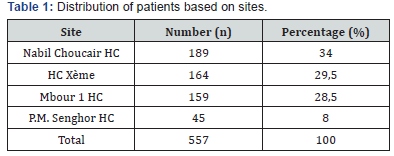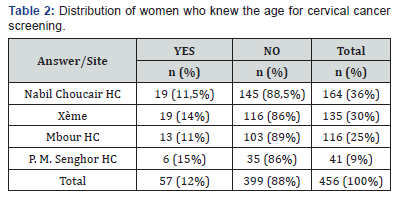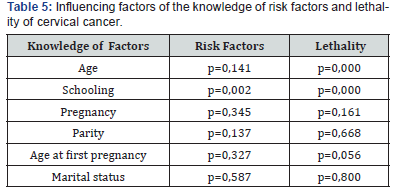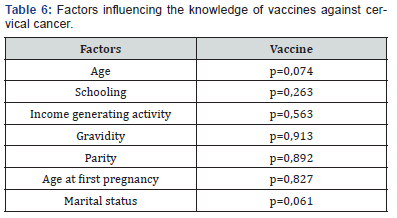Knowledge, Position and Practices of Women on Vaccination Against Human Papillomavirus in Two Regions of Senegal : About 557 Cases Interviewed Between 2015 And 2016
Omar Gassama 1*, Djibril Diallo1, Ousmane Thiam2, Babacar Biaye3, Nicole Fatou Binetou Gakou Sow1, Mor Cissé1, Mamadou Seye1, Moussa Diallo1, Mame Diarra Ndiaye Gueye1, Alassane Diouf1 and Jean Charles Moreau1
Submission: November 14, 2019;Published: November 25, 2019
*Corresponding author: Omar Gassama, Gynecological and Obstetric Clinic, Aristide Le Dantec University Hospital, Senegal
How to cite this article:Omar Gassama, Djibril Diallo, Ousmane Thiam, Babacar Biaye, Nicole Fatou Binetou Gakou Sow, Knowledge, Position and Practices of Women on Vaccination Against Human Papillomavirus in Two Regions of Senegal : About 557 Cases Interviewed Between 2015 And 2016. J Gynecol Women’s Health. 2019: 17(3): 555964. DOI: 10.19080/JGWH.2019.17.555964
Introduction
Cervical cancer is a cosmopolitan disease of the young woman, it is a real public health problem with more than 500,000 new cases and 265,000 deaths per year. This disease is the second leading cancer in developing countries such as Senegal [1-2]. Human papillomavirus (HPV) infection is a necessary condition for the development of cervical cancer [3]. Cervical cancer is preventable by a primary prevention that relies on vaccination against human Papillomaviruses and a secondary prevention by screening methods such as cervico-vaginal smear, visual inspection after application of acetic acid (VIA) and/or after application of Lugol and the HPV viral test.
However, in developing countries such as Senegal, access to these screening techniques is limited because of insufficient manpower, awareness programs, education and information on the disease and its risk factors, but also because of the lack of early and multidisciplinary concerted action of gynecologists, oncologists, general practitioners, midwives, nurses, etc ... The purpose of our study is to assess women’s knowledge, attitudes and practices about cervical cancer vaccination.
Materials and Methods
We conducted a prospective, cross-sectional, descriptive and analytical study about the knowledge and position of a population of women interviewed during two cervical cancer screening campaigns in the centers of Mbour on June 13th, 2015 and Philippe Maguilen Senghor on July 25th, 2015. The survey also included women who came for a visit in the centers of Xème Thiès and Nabil Choucair, between January 05th 2015 and June 03rd 2016. In practice, we conducted a survey using a semi-structuredquestionnaire developed for this purpose and used on a sample of 557 women. Patients who did not give their consent were excluded from the study.
Statiscal and Analysis
It was carried out through a structured individual interview using a previously developed questionnaire with 2 components:
a) The patients’ personal information like socio-demographic aspects and gynecological or obstetrical history
b) The knowledge and positions of these patients about vaccination against cervical cancer Thus, concerning the socio-demographic aspects, the information collected was: age, address, schooling, existence or not of income-generating activities (liberal, commercial or public).
For gynecological or obstetrical history, they concerned pregnancy, parity, age at first pregnancy, marital status. For cervical cancer knowledge, the questions were about the vaccination against it. Quantitative variables were described by the mean and qualitative data by the number (n) and percentage (%) using excel and epi info software. Statistical analysises were performed using Statistical Package for Social Science (SPSS) 20.0 with Fisher and Khi2 tests.
Result
We interviewed 557 women from different sites: 45 (8% of women) at the Philippe Maguilen Senghor Health Center, 164 (29.4% of women) at Xème as shown in Table 1. The average age of women was 35 with extremes of 18 and 66. The majority ofwomen were 39 to 48 years old (30%). Overall, 308 women went to school (55.3% of cases).

Trade represented the main source of income (44% of cases), especially among the population selected at the Mbour Health Center (61% of cases). The average number of pregnancy was 5 with extremes of 0 and 15. Patients with multiple pregnancies were the largest population (51% of cases) especially among the one recruited at the Philippe Maguilen Senghor Health Center where the average pregnancy was 6.5.
The average parity was 4.6 with extremes of 0 and 14. The average age at first pregnancy was 21 with extremes of 12 and 48. In our sample, the majority of women were married (81% of cases) in a monogamous regimen (50% of cases Majority of the women (80% of cases) didn’t know the risk factors of cervical cancer. However, 20% of interviewed women could list a few and mostly belonged to the women population selected at the Nabil Choucair Health Center (24% of cases). No women had mentioned human Papilloma Virus (HPV) infection as a risk factors.
The majority of women who knew about cervical cancer (70% of cases) had never been screened for it. The lowest screening rates were found among the population of women interviewed in Mbour (22% of cases) and Thiès (22% of cases). Only 12% of interviewed women who knew about cervical cancer were aware of the age at which the screening was recommended. Most of them belonged to the population of women selected in Xème Thiès Health Centers (14% of cases) and P.M. Senghor (15% of cases, Table 2).

Very few women (82 cases or 18%) aware of cervical cancer, knew about the existence of the vaccine against it. Most of them belonged to the population of women interviewed at the health centers of Mbour 1 (23% of cases) and P.M. Senghor (24% of cases). Among them, only three women (4% of cases) knewthe name of the vaccine and belonged to the population selected at Nabil Choucair Health Centers (8% of cases) and Mbour 1 (4% of cases) as shown in Tables 3&4.




A statistically meaningful link was found between schooling and knowledge of cervical cancer risk factors. The women that attended school knew better the cervical cancer risk factors (Table 5). A statistically meaningful link was made in terms of average age, schooling, source of income and the knowledge about the lethality of cervical cancer as illustrated in Table 5. The lethality of cervical cancer was mostly known by older women thatwent to school with income generating professional activities We found that knowledge about the cervical cancer vaccine was not influenced by any of the factors studied (Table 6).
Discussion
The women in our study about cervical cancer were 35 years old on average, mostly married (83% of cases) monogamous (46% of cases), went to school but housewives (63.2%). These results were confirmed by the 2013 General Census of the Population and Housing, Agriculture and Livestock (RGPHAE), which showed more married women (58% vs. 30.8% in 2002) than singles (34.3% vs 17.2% in 2002) [4]. In 2012, TRAORE also showed that although women were mostly educated (56.3%) and married (75%), they did not work (70%) [5]. This could be due to the Senegalese culture that wants the woman to stay at home to take care of the house.
On the other hand, concerning the ages, these results are different from those found in Dakar by Lemine And Gassama [6,7] in 2017 where the average age of the patients was 47.6 with extremes of 23 and 75 and by Traore [5] in 2012, where 63.5% of women were aged between 30 and 44 with an average age of 40.95 . Women interested to know about cervical cancer are getting younger and younger. This could be explained by the new technologies and communication channels, but also by the changes in behavior.
Obstetrical activity was important with an average pregnancies of 5 and an average parity of 4.5. The first pregnancy was at about 21 in accordance with socio-cultural beliefs Despite the known severity of the disease, our study found that only 28% of women with the disease had been screened, and only 12% of women surveyed knew of the age at which screening was recommended. This could be explained by the scarcity of contact with the nursing staff in our work conditions when there is no disease. Also, by the lack of systematic prescription of a screening by the nursing staff. This is confirmed by a study in Kuwait showing that 52.3% of women were tested, but only 23.8% had done so and the main reason given for not having smear tests was that the doctor did not suggest it [8].
Referring to the results obtained by Traore in 2012 (frequent use of screening of 20.8%), we can note an increase in this practice but it remains insufficient [5]. This could be explained by the numerous screening campaigns organized especially at the community level. Primary prevention with the vaccine was poorly known (18% of cases) with only 4% of these women knowing the names of available vaccines. There is therefore a lack of importantcommunication on the prevention of cervical cancer. In our study, the media allowed 71% of women to know about the existence of the vaccine and the prevention of cervical cancer, especially among the population interviewed at the Nabil Choucair Health Center (80% of cases).
In the FAYE study in Senegal, radio and community relays were the main sources of information in respectively 62% and (59%) [9]. Media, health providers and community relays need to play an important role in raising awareness about cervical cancer vaccination.
Conclusion
Knowledge about risk factors for cervical cancer and especially human Papillomaviruses can prevent cervical cancer. This prevention requires knowledge of available vaccines for the prevention of human papillomavirus infections. The media and community relays occupy a prominent place in awareness.
References
- Bray F, Ferlay J, Soerjomataram I, Siegel RL, Torre LA, et al. (2018) Global Cancer Stastistics 2018 : GLOBOCAN Estimates of Incidence and Mortality Worldwide for 36 Cancers in 185 Countries. CA Cancer J Clin 68(6): 394-424.
- Touré P, Ahmadou DB, Traoré MM, Dieng PS, Diop T, et al. (2008) Gynecological and mammary cancers at the dakar cancer Institute. Santé 18(1) : 25-29.
- Harald ZH, Meinhof W, Wiltrud S, George WB (1974) Attempts to detect virus-specific DNA in human tumors. I. Nucleid acid hybridizations with complementary RNA of human wart virus. Int J Cancer 13(5): 650-656.
- Agence Nationale de la Statistique et de la Démographie (2013) Recensement Général de la Population et de l’Habitat, de l’Agriculture et de l’Elevage (RGPHAE 2013) Chapitre IX, Etat matrimonial - Nuptialité, p. 267.
- Traoré MT (2012) Etude des déterminants du recours au dépistage du cancer du col de l’utérus dans le district centre Gaspard Kamara Mémoire, Economie de la santé, Dakar, Senegal.
- Lemine OA (2017) Lésions cervicales cytologiques de haut grade: aspects colposcopiques et thérapeutiques Thèse de Mé Dakar, Senegal, p. 303.
- Gassama O (2011) Bilan des activités de colposcopie à la Clinique Gynécologique et Obstétricale (CGO) de l’Hopital Aristide Le dantec Thése de Médecine. Dakar, Senegal, p. 43.
- Al Sairafi M, Mohamed FA (2009) Knowledge, Attitudes, and Practice Related to Cervical Cancer Screening among Kuwaiti Women. Med Princ Pract 18(1): 35-42.
- Adama Faye, Sidy Ndiaye, Khadim Niang, Mamadou Ndiaye, Anta Tal-Dia, et al. (2016) Déterminants of Vaccination Coverage Against Human Papillomavirus in 10-year-old Girls in 2016 in Rural Senegal. Sciences PG 5(6) : 464-468.






























